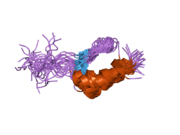Sp3 transcription factor
| View/Edit Human | View/Edit Mouse |
Sp3 transcription factor, also known as SP3, refers to both a protein and the gene it is encoded by.
This gene belongs to a family of Sp1 related genes that encode transcription factors that regulate transcription by binding to consensus GC- and GT-box regulatory elements in target genes. This protein contains a zinc finger DNA-binding domain and several transactivation domains, and has been reported to function as a bifunctional transcription factor that either stimulates or represses the transcription of numerous genes. Transcript variants encoding different isoforms have been described for this gene, and one has been reported to initiate translation from a non-AUG (AUA) start codon. Additional isoforms, resulting from the use of alternate downstream translation initiation sites, have also been noted.[3]
Interactions
Sp3 transcription factor has been shown to interact with Histone deacetylase 2,[4][5] PIAS1,[6] E2F1[7] and GABPA.[8]
References
- ↑ "Human PubMed Reference:".
- ↑ "Mouse PubMed Reference:".
- ↑ "Entrez Gene: SP3 Sp3 transcription factor".
- ↑ Won, Jaejoon; Yim Jeongbin; Kim Tae Kook (October 2002). "Sp1 and Sp3 recruit histone deacetylase to repress transcription of human telomerase reverse transcriptase (hTERT) promoter in normal human somatic cells". J. Biol. Chem. United States. 277 (41): 38230–8. doi:10.1074/jbc.M206064200. ISSN 0021-9258. PMID 12151407.
- ↑ Sun, Jian-Min; Chen Hou Yu; Moniwa Mariko; Litchfield David W; Seto Edward; Davie James R (September 2002). "The transcriptional repressor Sp3 is associated with CK2-phosphorylated histone deacetylase 2". J. Biol. Chem. United States. 277 (39): 35783–6. doi:10.1074/jbc.C200378200. ISSN 0021-9258. PMID 12176973.
- ↑ Sapetschnig, Alexandra; Rischitor Grigore; Braun Harald; Doll Andreas; Schergaut Marion; Melchior Frauke; Suske Guntram (October 2002). "Transcription factor Sp3 is silenced through SUMO modification by PIAS1". EMBO J. England. 21 (19): 5206–15. doi:10.1093/emboj/cdf510. ISSN 0261-4189. PMC 129032
 . PMID 12356736.
. PMID 12356736. - ↑ Rotheneder, H; Geymayer S; Haidweger E (November 1999). "Transcription factors of the Sp1 family: interaction with E2F and regulation of the murine thymidine kinase promoter". J. Mol. Biol. ENGLAND. 293 (5): 1005–15. doi:10.1006/jmbi.1999.3213. ISSN 0022-2836. PMID 10547281.
- ↑ Galvagni, F; Capo S; Oliviero S (March 2001). "Sp1 and Sp3 physically interact and co-operate with GABP for the activation of the utrophin promoter". J. Mol. Biol. England. 306 (5): 985–96. doi:10.1006/jmbi.2000.4335. ISSN 0022-2836. PMID 11237613.
Further reading
- Tseng L, Gao J, Mazella J, et al. (1997). "Differentiation-dependent and cell-specific regulation of the hIGFBP-1 gene in human endometrium.". Ann. N. Y. Acad. Sci. 828: 27–37. doi:10.1111/j.1749-6632.1997.tb48521.x. PMID 9329821.
- Zhang Y, Dufau ML (2003). "Dual mechanisms of regulation of transcription of luteinizing hormone receptor gene by nuclear orphan receptors and histone deacetylase complexes.". J. Steroid Biochem. Mol. Biol. 85 (2–5): 401–14. doi:10.1016/S0960-0760(03)00230-9. PMID 12943729.


